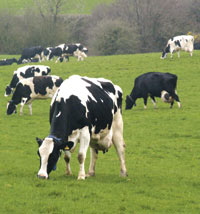Dairy Event 2009: Grass still makes sense for high yielding herds

Dairy farmers with herds producing more than 8000 litres say grazed grass can form a low-cost component of TMR without compromising yield.
When high yielding cows have an edge on their appetite and the grass they are grazing is of high quality then there is no reason why they can’t get a good level of their energy requirements from grass, says Martin Whell.
Mr Whell, who runs a herd of 300 cows at Lower Greadow, St Austell, is changing his farming system by moving away from pure Holsteins to crossbred cows, reducing milk yield from 10,000 litres to 8300 litres.
This is still a high yielding system, but with grass forming a more important part of it. He has been able maintain higher than average yields through good grazing techniques and making sure cows are not completely full when they go out to graze. “Grass is hard to manage, you have to pay a lot of attention. If you just turn cows out then it’s going to go wrong,” he admits.
Mr Whell insists on cows being in calf before he pushes up their grass intakes. Before the high yielders are in calf they only get up to 20% of their diet requirements from grass. “Once a cow is pregnant she is bomb proof. We push them hard to get grass down tight and this restores the quality,” he says. “Cows would be getting about 16kg DM from grazed grass.”
The herd is on a 16-24 day rotation, depending on the time of the year. When grass is growing too fast it is mown to maintain quality.
How the grass is presented is important. Mr Whell doesn’t force high yielders to eat grass beyond a certain level, which means they get the maximum benefit from every mouthful.
There have been sacrifices that have been made from the move to a more grass-based system. The pregnancy rate this year was 45% compared to 55% last year. But what have improved are levels of mastitis and lameness.
“It’s about what I morally think is right. I think cows enjoy going out for eight hours a day. Cows love a change in their routine and going outside is different as is eating grass,” says Mr Whell. “I hope that doesn’t impinge too hard on fertility, but you have to balance this with other health improvements we are seeing in the herd.”
Grass management is important in this system. The fields are regularly topped. “We like to mow grass down fairly hard, this gives high quality grass and that’s what gives the milk production on the next grazing round. If we didn’t top, grass would become more mature and we wouldn’t get the quality,” he says.
Mr Whell uses a rising plate meter to measure covers and calculate dry matter intakes. “I walk the farm with a plate meter every seven to 10 days to gauge how well grass is growing so I know if we are going into a situation where we will be short of grass,” he says.
“The main drawback with grazing high yielding cows is that it is not just one system you are operating but two – TMR and grazing. It takes more time to manage two systems and it can be difficult.
Piers Badnell, DairyCo extension officer, agrees grass must be managed well to get optimum quality and use. A plate meter and a rotational grazing system are integral to this.
Mr Badnell says farmers who fill their cows up with a TMR buffer are missing out on huge potential. He says farmers with high yielding herds are increasingly using grazed grass as part of TMR. “Five years ago farmers with yields of 8000 litres plus thought what I was proposing was fairly ridiculous, but they are now taking it on board,” he says.
“They are aware of what’s possible because they know what dry matter is going in and are learning grazing techniques. It’s a matter of using techniques that are typical of low yielding grazing systems and learning to use those in a high yielding situation.”
- Click here for more on the Dairy Event and Livestock Show 2009
